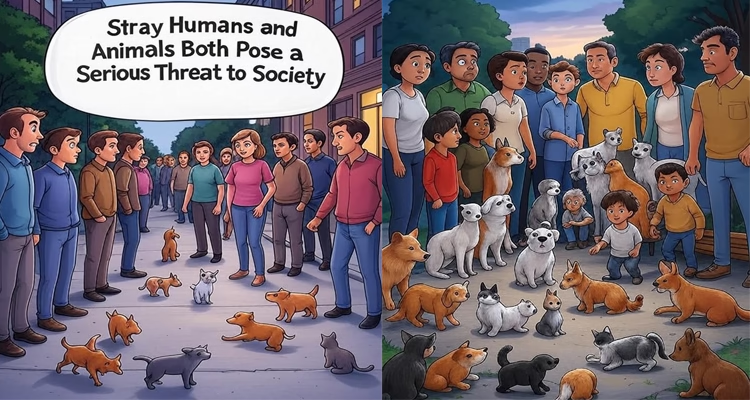
 India’s majority society is often considered emotionally straightforward and deeply compassionate towards nature and animals. At times, people show more empathy toward animals than humans. Seeing a cow sitting on the street, people fold their hands in reverence; giving a biscuit to a dog makes them feel benevolent, and on social media, hashtags are run to prove themselves as animal lovers. But behind this glossy image lies a bitter reality: often, this compassion is hollow and serves as an excuse to avoid responsibility. The millions of stray animals wandering India’s streets bear witness to the fact that in the name of emotions, we are merely pretending. In reality, we neither take care of them properly nor consider human safety. It would not be wrong to say that whether stray humans or stray animals, both pose a significant threat to society. It is in the society’s best interest to stay cautious of such dangers.
India’s majority society is often considered emotionally straightforward and deeply compassionate towards nature and animals. At times, people show more empathy toward animals than humans. Seeing a cow sitting on the street, people fold their hands in reverence; giving a biscuit to a dog makes them feel benevolent, and on social media, hashtags are run to prove themselves as animal lovers. But behind this glossy image lies a bitter reality: often, this compassion is hollow and serves as an excuse to avoid responsibility. The millions of stray animals wandering India’s streets bear witness to the fact that in the name of emotions, we are merely pretending. In reality, we neither take care of them properly nor consider human safety. It would not be wrong to say that whether stray humans or stray animals, both pose a significant threat to society. It is in the society’s best interest to stay cautious of such dangers.
Imagine this: amidst traffic jams, a cow is chewing on a plastic bag, covered in mud and dust. People see it and move ahead without thinking. No one considers that it is we who are responsible for throwing that bag on the road. That same bag could eventually cause the cow’s death. A little further down the street, dozens of dogs fight over bones found in the trash. What humans discard becomes a lifeline for them. These scenes often end up on social media through the camera of a “compassionate” urbanite, yet in real life, these animals are left on the streets to fend for themselves. According to the 2019 livestock census, India has nearly 5 million stray cows. This number is not due to any external crisis but our own negligence. About 95% of these cows are abandoned by dairy farmers when they stop producing milk. Their reasoning is simple: maintaining them would increase the cost of fodder, so they let them roam the city streets, where they rummage through trash and eat plastic, gradually falling ill. Cows’ stomachs get filled with plastic, their intestines get damaged, and the streets get covered in dung. But who takes responsibility? Everyone thinks that since the cow is considered sacred, someone will inevitably take care of it, and thus the problem remains unresolved.
The problem with dogs is even more alarming. India is home to the highest number of stray dogs in the world about 60 million. This means that in India’s population of 1.4 billion, every 23rd person shares space with a stray dog. While this figure may sound interesting, its consequences are extremely dangerous. Every year, around 3.7 million people in India are bitten by dogs. India alone accounts for 36% of all rabies-related deaths worldwide. This shocking statistic shows that our compassion is turning deadly. Recently, just in Delhi, by mid-2025, more than 35,000 dog-bite cases and about 50 deaths were reported. This problem is no longer only about animals; it has become a direct threat to human life. Perhaps keeping this in mind, the Supreme Court issued strict orders to catch stray dogs. Yet, despite recognizing the danger, both society and the government remain complacent. Politicians use cows as vote banks, municipal authorities treat animal control as minor tasks like filling potholes, and the urban elite gain social media applause by posting dog videos. Nowhere in this game does responsibility appear. This is why when the Supreme Court recently proposed relocating 1 million dogs in Delhi, nationwide outrage ensued. People labeled it as “massacre.” Certainly, dogs have a right to live, and placing them in inhumane shelters is wrong. But the question remains: who will solve this problem? Will mere anger or lighting candles eliminate the issue?
The mathematics of the dog population is frightening. A single unsterilized female dog, if allowed to breed continuously for six years, can produce hundreds of puppies. In other words, if action is not taken now, India’s streets could be overrun with dogs in the coming years. The only solution is a structured sterilization and vaccination campaign. We must understand that this is as crucial as eradicating polio once was. If polio could be eliminated, the stray animal problem can also be solved, provided policies are strict and accountability is enforced.
As for solutions, every cow must be mandatorily registered. If a farmer abandons a cow on the street, fines should be imposed, and the cow should be seized. Subsidized gaushalas (cow shelters) should be digitally tracked and funded based on the number of cows they care for. This money should not end up in any politician’s pocket but go directly to the shelter. Similarly, organized sterilization and vaccination programs must be initiated for dogs. Every district should have a Dog Control Board with annual audits, ensuring the officials are held accountable.
Where will the funding come from? It’s a valid question, but the answer is simple. If billions can be spent on statues, rallies, and election promises, why not on animal and human safety? Every household could pay a small dog tax, a portion of MPs’ and MLAs’ constituency funds could be allocated, and Corporate Social Responsibility (CSR) funds could be used. Money spent today on this campaign will prevent thousands of future problems.
The Jaipur model serves as a successful example. In 1994, the municipal corporation and an NGO started a program to catch dogs, sterilize and vaccinate them, and then release them. This controlled the dog population and reduced rabies cases. The cost per dog ranges from 800 to 2,200 rupees, covered by donations from the municipal corporation and citizens. If this model is adopted nationwide, linked with digital tracking, and included in the performance reports of mayors and district collectors, the problem can be effectively managed.
(Written by Ajay Kumar, Senior Journalist, Lucknow)



